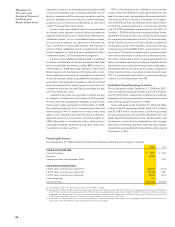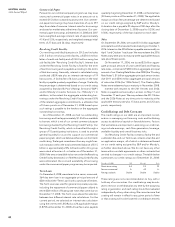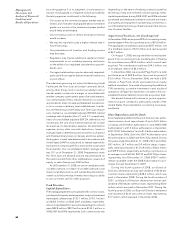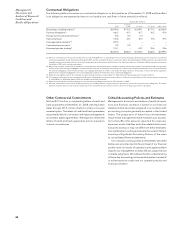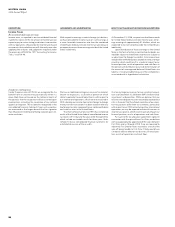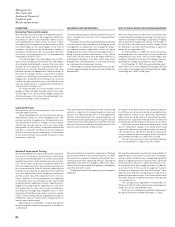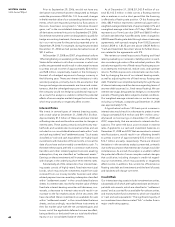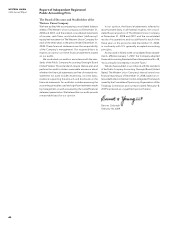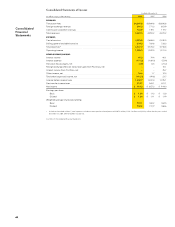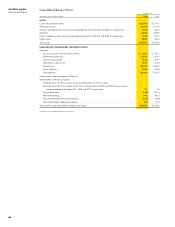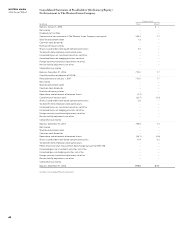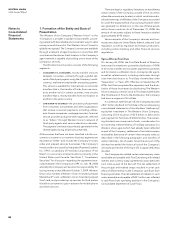Western Union 2008 Annual Report Download - page 42
Download and view the complete annual report
Please find page 42 of the 2008 Western Union annual report below. You can navigate through the pages in the report by either clicking on the pages listed below, or by using the keyword search tool below to find specific information within the annual report.WESTERN UNION
2008 Annual Report
4040
Prior to September 29, 2006, we did not have any
derivative instruments that were designated as hedges
under the provisions of SFAS No. 133. As a result, changes
in the fair market value of our outstanding derivative instru-
ments, which are impacted primarily by fluctuations in
the euro, have been recognized in “derivative (losses)/
gains, net” in the consolidated statement of income for
all derivatives entered into prior to September 29, 2006.
Since these instruments were not designated to qualify for
hedge accounting treatment, there was resulting volatil-
ity in our net income for the periods presented prior to
September 29, 2006. For example, during the year ended
December 31, 2006 we had pretax derivative losses of
$21.2 million.
At December 31, 2008 and 2007, a hypothetical uniform
10% strengthening or weakening in the value of the United
States dollar relative to all other currencies in which our
profits are generated would result in a decrease/increase
to pretax annual income of approximately $24 million
and $28 million, respectively, based on the Company’s
forecast of unhedged exposure to foreign currency in
the following year. There are inherent limitations in this
sensitivity analysis, primarily due to the assumption that
foreign exchange rate movements are linear and instan-
taneous, that the unhedged exposure is static, and that
the company would not hedge any additional exposure.
As a result, the analysis is unable to reflect the potential
effects of more complex market changes that could arise,
which may positively or negatively affect income.
Interest Rates
We invest in several types of interest bearing assets,
with a total value at December 31, 2008 of $1.5 billion.
Approximately $1.3 billion of these assets bear interest
at floating rates and are therefore sensitive to changes in
interest rates. These assets primarily include money mar-
ket funds and variable rate municipal securities and are
included in our consolidated balance sheets within “cash
and cash equivalents” and “settlement assets.” Such assets
classified as “cash and cash equivalents” are highly liquid
investments with maturities of three months or less at the
date of purchase and are readily convertible to cash. To
the extent these assets are held in connection with money
transfers and other related payment services awaiting
redemption, they are classified as “settlement assets.”
Earnings on these investments will increase and decrease
with changes in the underlying short-term interest rates.
Substantially all of the remainder of our interest bear-
ing assets consist of highly rated, fixed rate municipal
bonds, which may include investments made from cash
received from our money transfer business and other
related payment services awaiting redemption classified
within “settlement assets” in the consolidated balance
sheets. As interest rates rise, the fair market value of these
fixed rate interest-bearing securities will decrease; con-
versely, a decrease to interest rates would result in an
increase to the fair market values of the securities. We
have classified these investments as available-for-sale
within “settlement assets” in the consolidated balance
sheets, and accordingly, recorded these instruments at
their fair market value with the net unrealized gains and
losses, net of the applicable deferred income tax effect,
being added to or deducted from our total stockholders’
equity on our consolidated balance sheets.
As of December 31, 2008, $1,242.9 million of our
total $3,143.5 million in debt carries a floating interest
rate or matures in such a short period that the financing
is effectively a floating rate position. Of this floating rate
debt, $82.9 million represents commercial paper with a
weighted-average interest rate of approximately 4.1% and
a weighted-average initial term of 27 days, $500 million
represents our Term Loan due 2009 and $660.0 million
is fixed-rate debt that has effectively been changed to
LIBOR-based floating rate debt through interest rate swap
agreements, with spreads ranging from 0.0025 percent
below LIBOR to 1.8125 percent above LIBOR. Refer to
“Cash and Investment Securities” above for further discus-
sion related to the agreements with IPS.
We review our overall exposure to floating and fixed
rates by evaluating our net asset or liability position in each,
also considering duration of the individual positions. We
actively manage this mix of fixed versus floating exposure
in an attempt to minimize risk, reduce costs, and optimize
returns. Portfolio exposure to interest rates can be modi-
fied by changing the mix of our interest bearing assets,
as well as adjusting the mix of fixed versus floating rate
debt. The latter is accomplished primarily through the use
of interest rate swaps and the decision regarding terms of
any new debt issuances (i.e., fixed versus floating). We use
interest rate swaps designated as hedges, to increase the
percent of floating rate debt, subject to market conditions.
Our weighted-average interest rate on our borrowings,
including our hedges, outstanding at December 31, 2008
was approximately 5.1%.
A hypothetical uniform 100 basis point increase in
interest rates would result in a decrease to pretax income
of approximately $12.4 million and $9.1 million annu-
ally based on borrowings on December 31, 2008 and
2007, respectively, that are sensitive to interest rate fluc-
tuations. The same 100 basis point increase in interest
rates, if applied to our cash and investment balances on
December 31, 2008 and 2007 that are sensitive to interest
rate fluctuations, would result in an offsetting benefit
to pretax income of approximately $13.0 million and
$16.7 million annually, respectively. There are inherent
limitations in the sensitivity analysis presented, primarily
due to the assumption that interest rate changes would be
instantaneous. As a result, the analysis is unable to reflect
the potential effects of more complex market changes
that could arise, including changes in credit risk regard-
ing our investments, which may positively or negatively
affect income. In addition, the current mix of fixed versus
floating rate debt and investments and the level of assets
and liabilities will change over time.
Credit Risk
Our interest earning assets include investment securities,
substantially all of which are highly-rated state and munici-
pal debt instruments, which are classified in “settlement
assets” and accounted for as available-for-sale securities,
and money market fund investments, which are classified
in “cash and cash equivalents.” The significant majority of
our investment securities are rated “AA-” or better from a
major credit rating agency.



